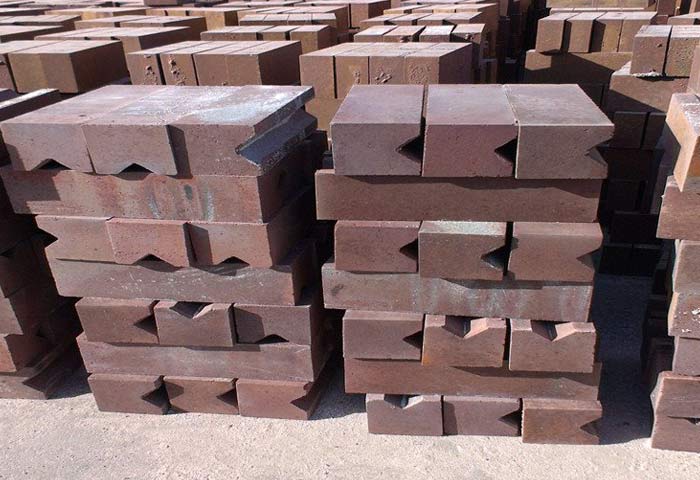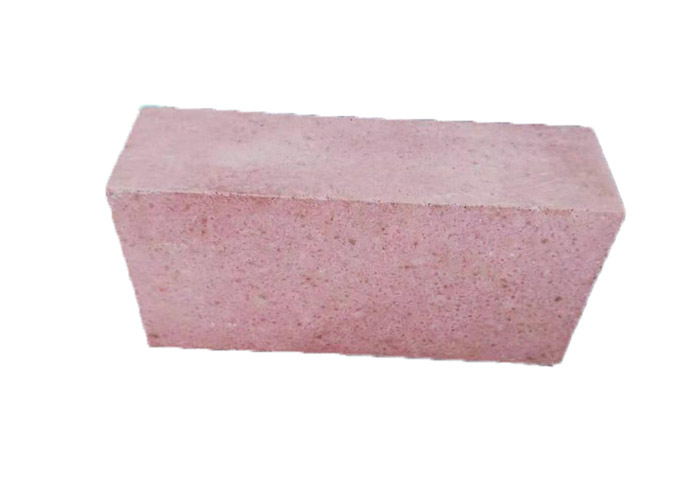Tijolos cromados

Tijolos cromados são tijolos neutros, usado principalmente como uma camada de isolamento para refratários ácidos e alcalinos em altas temperaturas, e também usado como forro de fornos de fundição não ferrosos.
No entanto, não deve ser usado em contato direto com o ferro e a atmosfera muda com frequência.
Tijolo cromado no forno de vidro começou a ser usado. Mas limitado a garrafas escuras e potes de vidro ou forno de fibra de vidro sem álcalis.
E usado principalmente nas partes de alta temperatura do forno de vidro. Como a parede da piscina superior, Boca de forno pequeno, orifício líquido fluido, carregando boca, e outros lugares, Porque pode estender significativamente a idade do forno.
Por empresa produz tijolos refratários de alta qualidade, incluindo tijolos de barro refratários, tijolos refratários de alta alumina, tijolos refratários de sílica, tijolos refratários de magnésia, tijolos de mulita, tijolos de isolamento, etc.
Enquanto isso, Se você está interessado em nosso produtos de tijolo refratário, ou se você está planejando construir uma fornalha ou forno, você pode entrar em contato conosco! Nós responderemos a você prontamente com aconselhamento profissional e um preço competitivo!
Mais tipos de tijolos cromados

Tijolos de alumínio-cromo
O tijolo AlCr é um tijolo com alto teor de alumina com Al2O3 como componente principal e uma pequena quantidade de Cr2O3.
O tijolo sinterizado feito de escória alcr também é tijolo alcr, Também chamado de tijolo de escória alcr. Tijolo de alumínio-cromo do que tijolo de alta resistência à erosão de alumina, tijolo de escória de alumínio-cromo, e propriedades mecânicas de alta temperatura de boas características.
O tijolo AlCr tem muitas vantagens, como alta densidade, baixa porosidade, alta resistência de união, alta dureza, suavidade de alta carga, boa resistência ao desgaste, anti-limpeza, boa resistência ao choque térmico, forte resistência ao derretimento de metal e à corrosão por escória, vida longa, etc.
Que é amplamente utilizado em vários equipamentos de fundição e outros fornos de temperatura ultra-alta.

Tijolo cromo de magnésio
O tijolo de magnésia-cromo comum é feito de areia e cromita de magnésia sinterizada como matérias-primas, em proporção apropriada, formando e disparando de alta temperatura.
A composição mineral do produto é magnésita, espinélio, e uma pequena quantidade de silicato.
Tijolo de magnésia-cromo comum tem boa resistência à escória alcalina, melhor resistência à escória ácida do que tijolo de magnésia, Melhor resistência ao choque térmico do que tijolo de magnésia, temperatura de amolecimento mais alta de carga, e boa estabilidade de volume em alta temperatura, Pequeno encolhimento da linha refutada em 1500 ℃.
Tijolo de alumínio de magnésio tem boa resistência à escória, Desempenho de alta temperatura, e estabilidade térmica, O preço é mais barato que o tijolo espinélio de magnésio.
Eles são amplamente utilizados no telhado de fornos planos a aço e ainda são usados em conchas de aço, Finios de forno de siderúrgica, Câmaras de armazenamento de calor do forno de vidro, Fornos de ferro misto, telhados de forno reflexo de cobre, e fornos refratários de alta temperatura da indústria.
Tipos e características de tijolos de magnésio-cromo
Atualmente, Existem vários tipos de tijolos de cromo de magnésio produzidos através de diferentes métodos, incluindo tijolo comum, Tijolo de ligação direta, tijolo sinterizado comum, Re-Bonding Brick, e tijolo de fundição de fusão.
1. Tijolo cromado de magnésia comum
Este é o produto tradicional, com minério cromo como partículas grossas e areia de magnésio como um pó fino. Ou dois materiais usando composição de partículas graduadas, A temperatura de disparo é geralmente 1550 ~ 1600 ℃. A microestrutura deste tijolo mostra pouca combinação direta entre partículas de cromita e magnésito, principalmente silicato (Cms) cimentação ou isolamento de fissura. Fang magnesita na fase de dessolvation, A matriz raramente é diretamente combinada, As propriedades mecânicas deste tijolo são ruins, baixa resistência à corrosão da escória.
2. Tijolo de magnésia-cromo diretamente combinado
Diretamente combinado com tijolo de magnésio-cromo é desenvolvido com base em tijolos comuns de magnésio-cromo. Suas características de produção são principalmente dois pontos, um é o uso de matérias -primas mais puras, e o segundo é o uso de temperatura de disparo mais alta. A chamada ligação direta significa que há mais contato direto entre partículas de cromita e magnésito no tijolo. Porque há menos Si02 na matéria -prima (controlado abaixo 1% para 2%), Menos silicato é gerado. Então o silicato é extrudado no canto das partículas de fase sólida usando disparos de alta temperatura, melhorando assim a ligação direta da fase sólida.
Tijolo de magnésio-cromo de ligação direta devido ao alto grau de ligação direta, para que o tijolo tenha uma força de alta temperatura, resistência à escória, resistência à erosão, resistência a limpeza, resistência à corrosão, e excelente estabilidade de choque térmico e estabilidade de volume em 1800 ℃.
3. Tijolo comum de magnésio sinterizado
Este processo de produção de produtos é caracterizado por uma certa proporção de areia de magnésio e cromita, mistura de pó fino de combustão de alta temperatura. Para alcançar a geração de espinélio secundário e magnésia-cromita, ligação direta para reação em fase sólida, a produção de material de sinterização comum. Este material é usado para fabricar produtos sinterizados ou produtos quimicamente ligados.
Os tijolos de magnésia-cromo co-sinterizados têm melhor ligação direta e homogeneidade microestrutural do que os tijolos diretamente ligados, com mais fase de dessolvação magnésita e espinélio secundário intergranular, Os tijolos de magnésia-cromo co-sinterizados têm uma série de propriedades melhores do que os tijolos diretamente ligados, especialmente conhecido por força de alta temperatura, Resistência à rápida mudança de temperatura e resistência à escória.
4. Tijolo combinado de magnésio-cromo
Método de fusão elétrica para fazer derreter em pó misto de magnésio-cromo, através do cristal de precipitação por fusão, a formação de uma microestrutura bastante uniforme, Espinel de magnésio-cromo, e cristal misturado por magnésita como a principal composição da fase da matéria -prima, O material elétrico de fusão de magnésio-cromo esmagou em um determinado tamanho de partícula, moldagem mista, disparando para preparar o tijolo combinado, ou usado diretamente para fazer tijolos quimicamente ligados.
Sobre a empresa de refratários PER


PER Refratários Company está localizada na cidade de Xinmi, Província de Henan, a cidade natal de materiais refratários na China. Nossa empresa é uma empresa refratária de base tecnológica que integra R&D, Produção, vendas, e serviço técnico. A riqueza de recursos e a excelente qualidade do território proporcionam condições superiores ímpares para a produção de materiais refratários. Nossos principais produtos são tijolos de barro refratários, tijolos refratários de alta alumina, tijolos refratários de sílica, tijolos refratários de magnésio, tijolos de mulita, tijolos de isolamento, e outro produtos resistentes a altas temperaturas.
Empresa PER refratário é a base de produção de verde, economia de energia, e novos materiais refratários ecológicos. Nossa empresa passou ISO9001:2008 certificação do sistema de qualidade internacional e GB/T24001-2004 / ISO14001:2004 certificação do sistema de gestão ambiental, certificação de agência de inspeção de qualidade empresarial. Nossos produtos são vendidos bem em mais de 20 países em todo o mundo. Eles são os produtos refratários preferidos para metalurgia, não ferroso, petroquímica, vidro, cerâmica, e outras indústrias refratárias.
